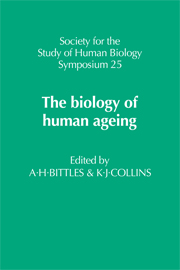Book contents
- Frontmatter
- Contents
- Preface
- Ageing as a consequence of natural selection
- Genetic information in ageing cells
- Insects as models for testing theories of ageing
- Human cell culture systems in the study of ageing
- Estimation of biological maturity in the older child
- Biological age assessment in adulthood
- Skeletal age and palaeodemography
- Cell death and the loss of structural units of organs
- The prospects for mortality decline and consequent changes in age structure of the population
- Where do old people come from? An evaluation of American population projections
- Age structure of Soviet population in the Caucasus: facts and myths
- The health of an ageing population
- Can we tell our age from our biochemistry?
- Dietary manipulation of ageing: an animal model
- Customary physical activity in the elderly
- Effects of ageing on human homeostasis
- Index
Biological age assessment in adulthood
Published online by Cambridge University Press: 06 August 2010
- Frontmatter
- Contents
- Preface
- Ageing as a consequence of natural selection
- Genetic information in ageing cells
- Insects as models for testing theories of ageing
- Human cell culture systems in the study of ageing
- Estimation of biological maturity in the older child
- Biological age assessment in adulthood
- Skeletal age and palaeodemography
- Cell death and the loss of structural units of organs
- The prospects for mortality decline and consequent changes in age structure of the population
- Where do old people come from? An evaluation of American population projections
- Age structure of Soviet population in the Caucasus: facts and myths
- The health of an ageing population
- Can we tell our age from our biochemistry?
- Dietary manipulation of ageing: an animal model
- Customary physical activity in the elderly
- Effects of ageing on human homeostasis
- Index
Summary
INTRODUCTION
Human biologists have devoted considerable effort to devising biological age measurement techniques for childhood, and these have been used with success in evaluating variation in developmental rates. Although the concept of biological age is equally appropriate to the ageing process, there has been much less progress in measurement of this latter phase of the life cycle. The lack of progress is in part due to the newness of gerontology as a scientific discipline, but also to the unique features of the ageing process itself. While the sexual, dental and skeletal development of the child progresses through a series of relatively invariant stages, ageing changes (with the exception of menopause in the female) are progressive rather than stepwise. Further, while most children are healthy, as adulthood progresses the divergence in health becomes considerable, and identifying completely healthy aged individuals is difficult. When the long duration of human ageing is recognised, and is added to the uncertainty about when it begins and ends, it becomes clearer why biological age assessment has been less successful for adults than for children.
Gerontologists have recognized the importance of measuring biological age in adulthood and a number of authors have discussed possible approaches to the problem (Benjamin, 1947; Comfort, 1969; Bourliere, 1970; Shock, 1977). Several investigators have developed biological age scales using diversified batteries of physiological tests. Typically, test parameters are selected based on their cross-sectional linear correlation with chronological age. This approach assumes that those traits which vary most closely with age are the best indicators of the ageing process.
- Type
- Chapter
- Information
- The Biology of Human Ageing , pp. 81 - 94Publisher: Cambridge University PressPrint publication year: 1986
- 10
- Cited by

